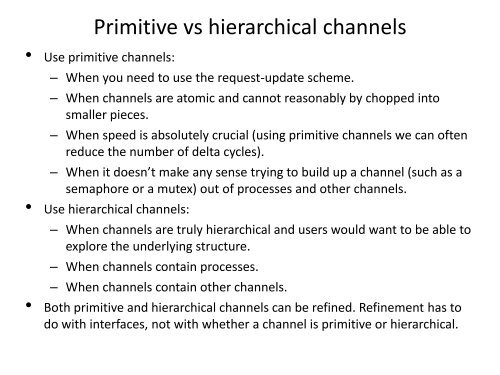Interfaces, channels and ports
Interfaces, channels and ports
Interfaces, channels and ports
You also want an ePaper? Increase the reach of your titles
YUMPU automatically turns print PDFs into web optimized ePapers that Google loves.
Primitive vs hierarchical <strong>channels</strong><br />
• Use primitive <strong>channels</strong>:<br />
– When you need to use the request-update scheme.<br />
– When <strong>channels</strong> are atomic <strong>and</strong> cannot reasonably by chopped into<br />
smaller pieces.<br />
– When speed is absolutely crucial (using primitive <strong>channels</strong> we can often<br />
reduce the number of delta cycles).<br />
– When it doesn’t make any sense trying to build up a channel (such as a<br />
semaphore or a mutex) out of processes <strong>and</strong> other <strong>channels</strong>.<br />
• Use hierarchical <strong>channels</strong>:<br />
– When <strong>channels</strong> are truly hierarchical <strong>and</strong> users would want to be able to<br />
explore the underlying structure.<br />
– When <strong>channels</strong> contain processes.<br />
– When <strong>channels</strong> contain other <strong>channels</strong>.<br />
• Both primitive <strong>and</strong> hierarchical <strong>channels</strong> can be refined. Refinement has to<br />
do with interfaces, not with whether a channel is primitive or hierarchical.
















